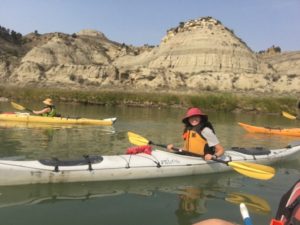 The Missouri River Breaks is a landscape dominated by striking sedimentary landforms, endless sagebrush flats, placid green water, acres of cattle, and men. While the latter two elements may seem minor in the geological timescale that has shaped the landscape, their influence in the last two centuries has been marked and undeniable. Cow pies score the banks of the river and dot the plains and motorboats—where permitted—ply the waters past the scars of tire tracks written on the dirt hills.
The Missouri River Breaks is a landscape dominated by striking sedimentary landforms, endless sagebrush flats, placid green water, acres of cattle, and men. While the latter two elements may seem minor in the geological timescale that has shaped the landscape, their influence in the last two centuries has been marked and undeniable. Cow pies score the banks of the river and dot the plains and motorboats—where permitted—ply the waters past the scars of tire tracks written on the dirt hills.
The presence of men in the Missouri River Breaks is notable less for the fact of their existence and more for the absence of women. In our 9 days on the river, the 11 women in our group represented the only female presence in the Breaks that we encountered. When our campsites were shared, we shared them with groups of male boaters, anglers, and hunters. In some ways, this gender imbalance was unsurprising to me; after all, according to the U.S Fish and Wildlife Service, in 2019 73% of all anglers and 89% of all hunters were male. However, it is telling to consider our brief experience of the Breaks within the greater context of history.
The majority of the American public is aware of the Missouri River Breaks of north-central Montana only in relation to the Lewis and Clark “Corps of Discovery” expedition of 1804-06. This expedition, sponsored by then-President Jefferson in order to facilitate westward expansion, was led and manned by an almost exclusively male crew, with the notable exception of Sacagawea. Prior to, during, and particularly after the culmination of the Lewis and Clark expedition, the major industries of the West were also male dominated. As Richard Manning writes in his 2009 book Rewilding the West, fur and whiskey trading, trapping, woodhawking, and horse thieving were the major economic activities occurring in the Breaks in the mid-to-late 1800s. Along with the timber and mining industries, these quintessentially Western occupations involved little to no female participation.
Vestiges of this history are apparent in the demographics of outdoor recreation today. While nationwide men outnumber women only marginally in participation in outdoor sports and recreation, our experience along the Missouri River did not align with this generalization. This particular region of the state continues to be skewed disproportionately towards male dominated recreation and business pursuits. According to data gathered in 2012, of the 529 firms owned in Phillips County, only 157 were female-owned. Ranching and agriculture serve as the primary forms of land use in the region, both historically and contemporarily predominantly male industries.
The intricacies of gender demographics in rural Montana may not seem all that relevant or important in the grand scheme of things; however, when considered in the context of conservation work along the Missouri River Breaks, it suddenly takes on a whole new dimension. The future of conservation in the Missouri River Breaks—and in the nation as a whole—depends upon a diverse and engaged citizenship who are invested in the future of our public lands. My experience of the Missouri River Breaks may have been an anomaly, or it may in fact have represented the drastic differences in gender participation in outdoor recreation in the area that it seemed to indicate. Either way, the conservation movement must begin to actively work to engage a wider array of individuals whose unique experiences and perspectives on public land will continue to shape the ways in which conservation work is performed. The ten women who accompanied me on this section of the course gave me hope that the future of conservation work can and will reflect the realities of our nation’s demographics. Their diverse backgrounds, interests, and perspectives have helped to inform my experience of this place, just as the conservationists of the future will continue to reshape and restore the dynamic landscape of the Missouri River Breaks.
Eva Happy is a student at Montana State University pursuing a degree in Liberal Studies. Raised in Eugene, Oregon she now thinks of Bozeman as home.
One Reply to “Gender and Conservation in the Missouri River Breaks By Eva Happy”
Comments are closed.
I love your thoughtful and articulate writing – you make many excellent points. I’m grateful that you, as one powerful woman, will keep actively and passionately engaging with the outdoors and sharing your voice with the world!